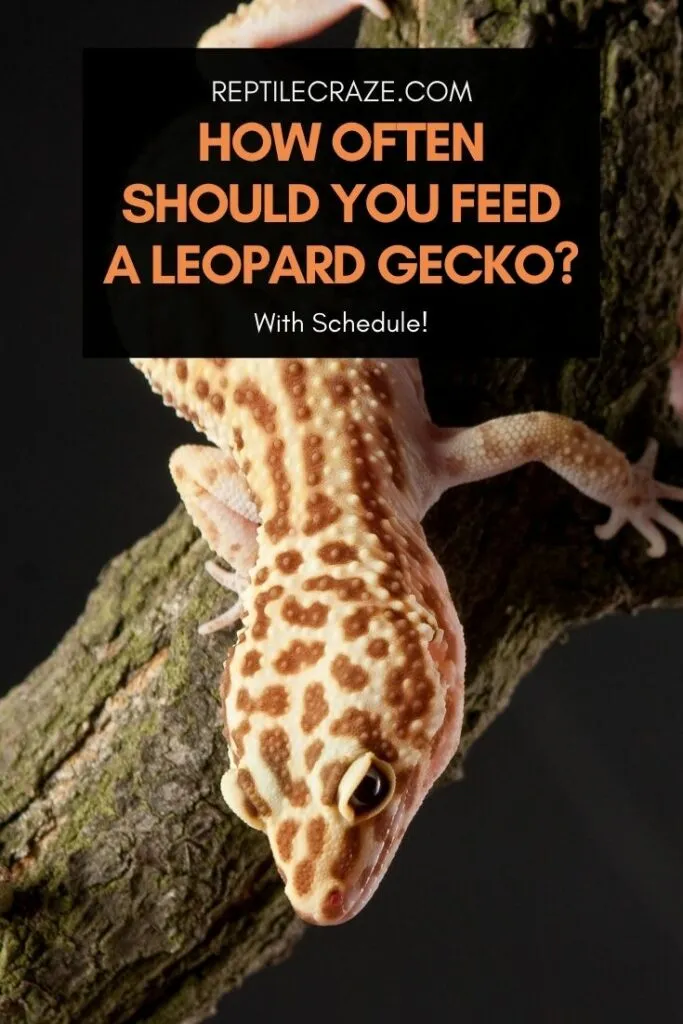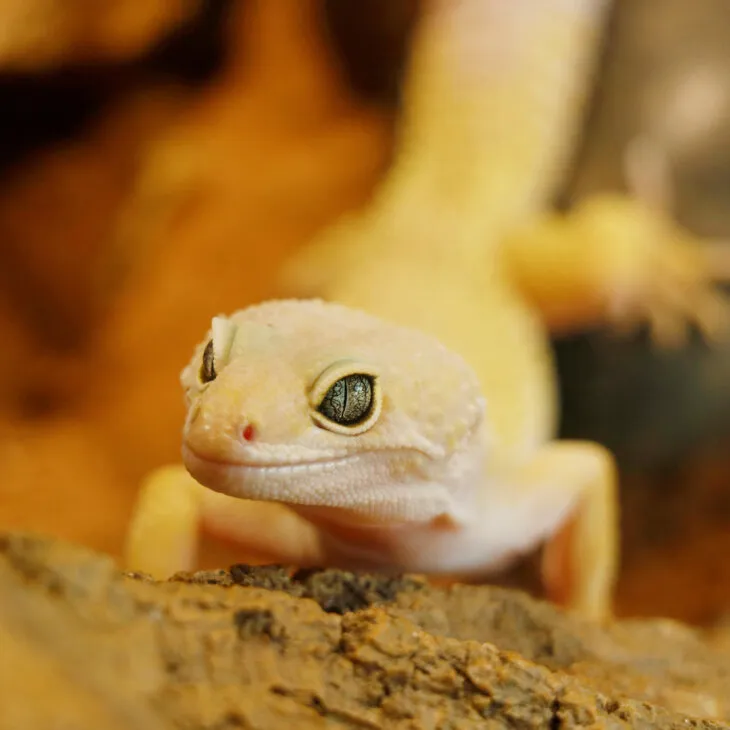
The frequency with which you need to feed your Leopard Gecko (Eublepharis macularius) changes depending on their development and health status. So, how often do you need to feed your Leopard Gecko?
Baby Leopard Geckos should be fed daily. Adults should be fed 2-3 times per week. Juveniles should be transitioned slowly between 4 to 12 months of age. Gravid Leopard Geckos may refuse
That’s the basic answer, but let’s find out how often you should be feeding your Leopard Gecko right now. We’ll also tackle some commonly asked questions.
Table of Contents
How Often To Feed Your Leopard Gecko By Age
Young Leopard Geckos are growing fast. They need lots of nutrients, especially protein and calcium, to grow healthily. As such, they need to be fed more often than adults.
Through the juvenile stage, from 4 to 12 months, you should introduce short periods of fasting to your Leopard Gecko’s diet. By the time they reach maturity at 12 months, they should be eating 2-3 times per week.
| Age of Leopard Gecko | Frequency of feeding |
| Baby0-4 months | Every day |
| Juvenile4-12 months | After 4 months of age, begin to punctuate the week with days off, until around 6 months, when they should eat every other day |
| Adult 12+ months | Every 2-3 days |
You should establish a good dietary routine by always offering
Find out more about why feeding at the right time is so important in our article here.
How Often To Feed A New Leopard Gecko
When you get a new Leopard Gecko, they will often refuse to eat while they settle into your home. Leopard Geckos are very sensitive to changes.
During this time, it is important to make water readily available. You should also try to establish a reliable feeding routine that your new Leopard Gecko can get used to.
In the beginning, offer
As soon as you get your new Leopard Gecko, measure and weigh it. Compare its weight and size with the average development rate of Leopard Geckos. You can refer to the approximate healthy weights below.
If your Leopard Gecko seems underweight or small, you may wish to feed them more often than you usually would. Just until you get them back on track.
Also, it is a great idea to introduce your new Leopard Gecko to your vet. This initial visit will establish them as a patient and help you get the best advice for feeding your new Leopard Gecko.
Tip: Read our leopard gecko diet guide to learn everything you must know on how to feed a leopard gecko.
Approximate Healthy Weight Of Leopard Geckos By Age
| Stage | Age | Weight | Body Length |
| Hatchling | 0 months | 2 – 4 grams newborn | 3 inches |
| Baby | 1 month | 15 – 25 grams | 4 – 5 inches |
| 2 – 3 months | 20 – 30 grams | 5 – 5.5 inches | |
| Juvenile | 4-5 months | 25 – 35 grams | 5.5 – 6 inches |
| 6 – 7 months | 30 – 40 grams | 6 – 6.5 inches | |
| 8- 9 months | 35 – 45 grams | 7 – 7.5 inches | |
| Adult | 10 – 12 months | 40 – 50 grams | 7.5 – 8 inches |
| 18 – 20 months | 60 – 90 grams | 8 – 12 inches |
How Often To Feed A Leopard Gecko That Is Laying Eggs
Quick answer: If your gravid Leopard Gecko is refusing
A gravid Leopard Gecko is a female who is growing eggs in her belly and preparing to lay. This can happen whether the female has mated or not.
A gravid female needs a lot of nutrients, especially protein and calcium. This is because growing eggs takes a lot of energy and nutritional building blocks.
As such, you need to ensure your female Leopard Gecko is eating a varied diet that is well supplemented with calcium and vitamins.
Unfortunately, gravid Leopard Geckos tend to stop eating as their pregnancy progresses. One reason for this is that their bellies become visibly swollen with eggs. This doesn’t leave a lot of room to eat big meals comfortably.
When your female Leopard Gecko starts refusing
It is totally normal that a female Leopard Gecko will refuse
Your female Leopard Gecko may struggle to find the energy or mobility to hunt effectively during this time. You can assist her to eat with gentle hand feeding.
Find out how to properly hand-feed a Leopard Gecko in our article here.

How Often To Feed A Leopard Gecko During Brumation
Quick answer: Do not feed a Leopard Gecko for 10 days before brumation or during brumation.
Seasonal temperature drops trigger wild Leopard Geckos to enter brumation. Brumation is similar to hibernation or torpor.
But, Leopard Geckos don’t tend to sleep solidly throughout. Instead, they may wake and walk around or drink.
If you choose to initiate a period of brumation for your pet Leopard Gecko, you will need to visit the vet first.
The vet needs to check for body condition and parasites and will advise you as to whether your Leopard Gecko is healthy enough to survive brumation.
If you do go ahead, you will need to put your Leopard Gecko through a fasting period before they enter brumation. Do not feed them anything. This is because if any
The microorganisms that cause the
Find out more about how long Leopard Geckos need to digest food in our article here.
During brumation, you should not feed your Leopard Gecko, even if they wake up. Following brumation, you will need to feed your Leopard Gecko a little more than usual. They will have lost weight and need to build up their fat stores.
FAQs
What Happens If You Feed A Leopard Gecko Too Often?
If you consistently feed your Leopard Gecko too often, you can cause them to gain too much weight. Eventually, this will lead to obesity-related illnesses. You can find out more in our article about why overfeeding is dangerous.
Is It OK To Feed My Leopard Gecko Every Day?
There are situations in which it is ok to feed your Leopard Gecko daily. Baby Leopard Geckos under the age of 4 months must be fed every day.
Also, sick Leopard Geckos, those who are gravid, or others who are not eating, should be offered
Can Leopard Geckos Eat Once Per Week?
Some owners report that they only feed their adult Leopard Geckos weekly. However, we recommend that adult Leopard Geckos should be fed 2-3 times per week. Read more in our article about how long Leopard Geckos can go without food.
- Enchi Ball Python: A Unique and Stunning Morph of Python regius - March 27, 2025
- Emerald Tree Monitor: The Enigmatic Green Guardian of the Rainforest - March 26, 2025
- The Egyptian Cobra (Naja haje): A Fascinating Serpent - March 25, 2025
